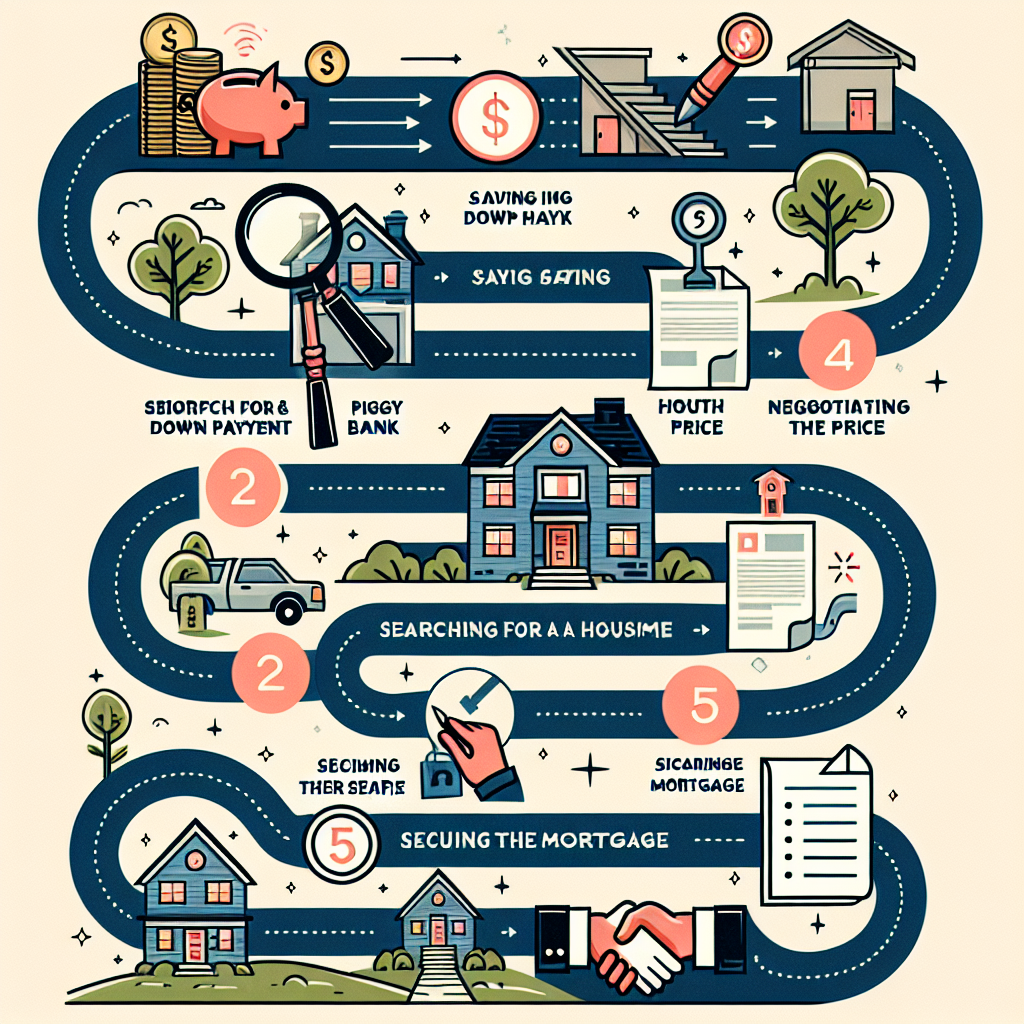-
Table of Contents
- Take Control: Essential Steps to Purchase Your First Home
- Understanding Your Financial Situation
- Assess Your Credit Score
- Calculate Your Budget
- Saving for a Down Payment
- Determine the Down Payment Amount
- Strategies to Save
- Getting Pre-Approved for a Mortgage
- Choose the Right Lender
- Gather Necessary Documentation
- House Hunting
- Define Your Needs and Wants
- Work with a Real Estate Agent
- Making an Offer
- Determine Your Offer Price
- Submit Your Offer
- Home Inspection and Appraisal
- Home Inspection
- Appraisal
- Closing the Deal
- Review Closing Documents
- Prepare for Closing Costs
- Sign the Paperwork
- Conclusion
Take Control: Essential Steps to Purchase Your First Home

Purchasing your first home is a monumental milestone that comes with a mix of excitement and anxiety. The process can be daunting, but with the right knowledge and preparation, you can navigate it successfully. This article will guide you through the essential steps to take control of your home-buying journey, from financial preparation to closing the deal.
Understanding Your Financial Situation
Before you start house hunting, it’s crucial to have a clear understanding of your financial situation. This will help you determine what you can afford and avoid future financial strain.
Assess Your Credit Score
Your credit score plays a significant role in securing a mortgage. Lenders use it to gauge your creditworthiness. A higher score can lead to better interest rates and loan terms.
- Check your credit report for errors and dispute any inaccuracies.
- Pay down outstanding debts to improve your credit score.
- Aim for a credit score of at least 620, though higher scores are preferable.
Calculate Your Budget
Understanding how much you can afford is essential. This involves more than just the mortgage payment; you need to consider other costs like property taxes, insurance, and maintenance.
- Use online mortgage calculators to estimate monthly payments.
- Consider the 28/36 rule: spend no more than 28% of your gross monthly income on housing expenses and no more than 36% on total debt.
- Factor in additional costs such as closing fees and moving expenses.
Saving for a Down Payment
One of the biggest hurdles for first-time homebuyers is saving for a down payment. The amount you need can vary, but generally, a larger down payment can reduce your monthly mortgage payments and eliminate the need for private mortgage insurance (PMI).
Determine the Down Payment Amount
While a 20% down payment is ideal, many first-time buyers put down less. However, putting down less than 20% usually requires PMI, which can add to your monthly costs.
- FHA loans require as little as 3.5% down.
- VA loans and USDA loans may offer zero down payment options for eligible buyers.
- Conventional loans typically require at least 5% down.
Strategies to Save
Saving for a down payment can take time, but with disciplined saving and smart financial planning, you can reach your goal.
- Set up a dedicated savings account for your down payment.
- Automate your savings to ensure consistency.
- Cut unnecessary expenses and redirect those funds to your savings.
- Consider additional income streams, such as freelance work or part-time jobs.
Getting Pre-Approved for a Mortgage
Before you start looking at homes, getting pre-approved for a mortgage can give you a clear picture of what you can afford and make you a more attractive buyer to sellers.
Choose the Right Lender
Not all lenders are created equal. Shop around to find a lender that offers competitive rates and terms that suit your financial situation.
- Compare interest rates and loan terms from multiple lenders.
- Read reviews and ask for recommendations from friends or family.
- Consider working with a mortgage broker who can help you find the best deal.
Gather Necessary Documentation
Lenders will require various documents to assess your financial health and determine your loan eligibility.
- Proof of income (pay stubs, tax returns, W-2 forms).
- Bank statements and other assets.
- Credit history and score.
- Identification documents (driver’s license, Social Security number).
House Hunting
With your finances in order and a pre-approval letter in hand, you can start the exciting process of house hunting. This step involves finding a home that meets your needs and fits within your budget.
Define Your Needs and Wants
Make a list of your must-haves and nice-to-haves. This will help you stay focused and avoid getting overwhelmed by options.
- Consider the number of bedrooms and bathrooms.
- Think about the location and proximity to work, schools, and amenities.
- Decide on the type of home (single-family, condo, townhouse).
- Consider future needs, such as space for a growing family.
Work with a Real Estate Agent
A real estate agent can be an invaluable resource in your home-buying journey. They have access to listings, market knowledge, and negotiation skills that can help you find the right home at the right price.
- Choose an agent with experience in your desired area.
- Ask for referrals from friends or family.
- Interview multiple agents to find one you feel comfortable with.
Making an Offer
Once you find a home you love, it’s time to make an offer. This step involves negotiating the price and terms with the seller.
Determine Your Offer Price
Your real estate agent can help you determine a fair offer price based on comparable homes in the area, the home’s condition, and market conditions.
- Consider the home’s listing price and how long it has been on the market.
- Factor in any repairs or renovations needed.
- Be prepared to negotiate with the seller.
Submit Your Offer
Your offer will include the price you’re willing to pay, any contingencies (such as a home inspection or financing), and the proposed closing date.
- Work with your agent to draft a strong offer letter.
- Include a personal letter to the seller if appropriate, explaining why you love the home.
- Be prepared for counteroffers and negotiations.
Home Inspection and Appraisal
After your offer is accepted, the next steps are the home inspection and appraisal. These steps ensure that the home is in good condition and worth the price you’re paying.
Home Inspection
A home inspection is a thorough examination of the property’s condition. It can reveal potential issues that may need to be addressed before closing.
- Hire a licensed and experienced home inspector.
- Attend the inspection to ask questions and learn about the home’s condition.
- Review the inspection report and negotiate repairs with the seller if necessary.
Appraisal
An appraisal is an assessment of the home’s value conducted by a professional appraiser. Lenders require an appraisal to ensure the home is worth the loan amount.
- The lender usually arranges the appraisal.
- If the appraisal is lower than the offer price, you may need to renegotiate with the seller or come up with the difference in cash.
Closing the Deal
The final step in the home-buying process is closing the deal. This involves signing the necessary paperwork, paying closing costs, and officially becoming a homeowner.
Review Closing Documents
Before closing day, review all the documents you’ll be signing. This includes the loan estimate, closing disclosure, and other legal documents.
- Ensure all terms and conditions match what you agreed upon.
- Ask your lender or real estate agent to explain any unclear terms.
- Verify that all agreed-upon repairs have been completed.
Prepare for Closing Costs
Closing costs can range from 2% to 5% of the home’s purchase price. These costs include fees for the loan, appraisal, inspection, and other services.
- Review the closing disclosure to understand all costs involved.
- Bring a cashier’s check or arrange a wire transfer for the closing costs.
- Have your identification and any required documents ready.
Sign the Paperwork
On closing day, you’ll sign all the necessary documents to finalize the purchase. Once everything is signed and the funds are transferred, you’ll receive the keys to your new home.
- Review each document carefully before signing.
- Ask questions if anything is unclear.
- Celebrate your new status as a homeowner!
Conclusion
Purchasing your first home is a significant achievement that requires careful planning and preparation. By understanding your financial situation, saving for a down payment, getting pre-approved for a mortgage, and working with a real estate agent, you can navigate the home-buying process with confidence. Remember to conduct thorough inspections and appraisals, and be prepared for closing costs. With these essential steps, you’ll be well on your way to taking control of your home-buying journey and achieving your dream of homeownership.








